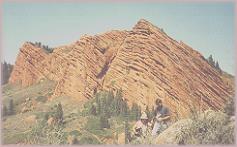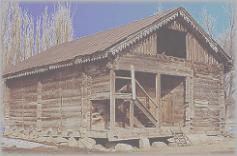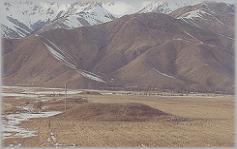Sandwiched between Kyrgyzstan's most spectacular mountains and Issyk-Kul, the second largest alpine lake in the world, Karakol makes the perfect base from which to delve into an unique range of exciting day trips. Blood-red cliffs, hot springs,
Scythian burial mounds, nomad camps and sandy beaches thousands of miles from the sea are all within easy reach.
You can find many articles, pictures,
reports about trekking in Karakol valley, Kyrgyzstan and Issyk-Kul Lake, Peak
Karakol, Djigit, Prjevalsky best routes. Day trips
Fishing Karakol area, Issyk-Kul lake and
surrounding rivers and ponds are the great places to have a perfect fishing.
Just ask the friendly local people to suggest you the best place for fishing for this
season, take a car and drive to the closest fishing place. More
information and pictures about fishing in Issyk-Kul Lake, rivers and pond and
kinds of fish. Altyn Arashan (Алтын Арашан) A picture-perfect alpine valley, Altyn Arashan's natural hot sulphur springs and peaceful beauty make
it one of Karakol's most spectacular excursions. In summer, the lush, green valley is dotted with yurts, horses and small groups of cheerful picnickers. Palatka (tent) Mountain, resembling a colossal marquee, looms over the foot of the valley and eagles circle far above. When the winter snows make access by jeep impossible, Altyn Arashan's slow stream of visitors dwindles almost to
a halt and the three bathhouse caretakers may not see a new face for weeks at a time. At this time of year, when wolves venture onto the valley floor and the only sound is the crack of avalanches high above, Altyn Arashan takes on an altogether different, wild kind of beauty. ). It is possible to bathe year-round in Altyn Arashan's hot sulphur springs, which are said to
have healing properties. Set 17km into the Terskey Ala-Too Mountains, Altyn Arashan can be reached in May-September along a steep, bumpy jeep track running up through the verdant Arashan Gorge. Year-round, a four-hour hike or a three hour ride from
the bottom of the gorge will bring you to the Valley. The valley can be visited as a day or overnight trip from Karakol. There are two hostels, each providing basic accommodation (although in summer many visitors prefer to camp or stay in a yurt. This is an opportunity for non-trekkers to gain a glimpse one of the most
quietly spectacular alpine settings in Eastern Kyrgyzstan. Djety-Oguz (Джеты-Огуз) Djety-Oguz, the extraordinary 'Valley of Seven Bulls', is famous for its unusually bright, red sandstone rock formations. Some of the valley's most celebrated landmarks include the 'broken heart' (a crimson,
heart-shaped precipice), the 'dragon's lair' (an spectacular, deep sandy canyon) and, of course, the 'seven bulls' themselves (a row of crags dominating the Djety-Oguz Valley). Centuries of snow and wind have eroded the rock face and multiplied the bulls from seven to nine, but Djety-Oguz remains no less impressive. These remarkable cliffs and their surrounding plateaux and valleys
make a popular day trip from Karakol. Numerous legends tell of how the valley and its curious rock formations were created. The Russian writer and explorer, Ivan Sokolov-Mikitov recounted the most famous local story. Click here for a synopsis. Besides
numerous walks and photo opportunities, Djety-Oguz has a small, clean late-Soviet sanatorium - another chance to rest your travel-weary limbs in natural hot springs or mud baths. Djety-Oguz is situated 35km from Karakol and can be easily visited as a day or half day trip. Turkestan is able to arrange guided walks, horse riding, picnics, eagle hunting displays,
horseback sports and concerts of traditional folklore music in the Djety-Oguz Valley. The Eagle Man of Djele-Debe Tintii Jamanakov, a 60-year-old eagle trainer, lives 22km from Karakol in Djele-Debe. Tintii caught his first
eagle as a boy, using the dangerous (and what would today be considered environmentally unsound) method of climbing up a mountain ravine to steal a nesting chick. As chicks, eagles are taught to recognize Tintii as their parent, then trained to hunt in the mountains and on the steppes - a traditional Kyrgyz practice still used today. Working eagles can weigh up to 12kg and live as long
as 30 years. Tintii's present eagle, 11 year old Natashka, catches hares, foxes, other birds, and on one occasion, a young wolf. Her quarry provides food and fur clothes for Tintii's family. Turkestan can arrange visits to Tintii and Natashka at their home in Djele-Debe and displays of eagle hunting techniques on fields nearby. This excursion fits well with a
half-day trip to Djety-Oguz (above). Svetly Mys (Светлый Мыс) The rural hamlet of Svetly Mys, 48km from Karakol, is heavy with history. As the reputed burial place of the apostle Matthew, a series of eight monasteries were founded here over two millennia. Many village buildings
are in fact the surviving structures of a 19th century Russian Orthodox monastery, founded by order of the Russian Tsar in 1888. In 1916 rebels attacked the monastery and all but two of its 26 monks were murdered. Of the surviving pair, Iraklii fled to Almaty and Seraphim to Ananyevo further down the lake. Both have since been canonised. The monks' storehouse is now a mill, the remains
of their church (most of which burnt down in the 30s) a craft workshop and their library still in use as a library today. From hills above, the village's roads can be seen to resemble an Orthodox cross. The village seems to abound in mysterious, shadowy happenings. The monastery church was once home to the miraculous icon of the Gentle Virgin Mary which cried blood, repelled bullets
and glowed with an ethereal light when under attack (see 'Russian Orthodox Cathedral' in the Karakol section for more information). Lydia Mikhailovna, a local teacher, saw monks' graves desecrated in the 50s and an enigmatic silver crucifix stolen. Her quest now is to trace the crucifix and return it to the church.  The 19th century almshouse and refectory has
been taken over and renovated by a cheerful local Kyrgyz couple, Gulnara and Ruslan, and their 25 adopted children. Turkestan excursions to Svetly Mys include lunch at this remarkable enterprise (which is called 'Spring Grace'). The 19th century almshouse and refectory has
been taken over and renovated by a cheerful local Kyrgyz couple, Gulnara and Ruslan, and their 25 adopted children. Turkestan excursions to Svetly Mys include lunch at this remarkable enterprise (which is called 'Spring Grace').
Several complexes of ancient catacombs, the underground cells of Armenian and other monks who came here over several centuries, surround
the village. Most are overgrown and filled with silt, but in two spots visitors can poke their heads through tiny holes in the ground and take a glimpse of this incredible spectacle. The more adventurous can clamber down inside and explore forgotten corridors and series of tiny rooms (although the crumbling, dry walls and ceilings are not very safe and visitors must do this at their own
risk!). Little visited by foreigners, this is discovery travelling at its best. Scythian Burial Mounds (Курганы)  Just outside Svetly Mys, on the main road to Ananyevo, are a series of large grassy mounds laid out in straight lines between the mountains and Lake Issyk-Kul. These are the burial
chambers of Sak tribe Scythian warriors and nobles, some of which are yet to be excavated. Similar mounds in Kazakhstan and to the south of the lake have yielded intricate jewellery, bronze vessels, armour and weapons. The most important Scythian archaeological treasure found to date is a golden warrior's costume made up of over 4,000 gold pieces. This 'golden man', excavated from a burial
mound in Esik, 40km outside Almaty, is a truly breathtaking piece of master craftsmanship. Amongst arrow shaped motifs, birds and snow leopards are winged mythical beasts and antelope - all finely worked in purest gold. A few pieces of the golden man can be seen on display at the Archaeological Museum in Almaty (although the majority are kept in a secure vault at the Kazak National Bank).
In early 2001 there were rumours that a second golden man had been found in a similar burial mound, also in Kazakhstan. Who knows what lies beneath the burial mounds outside Svetly Mys! Just outside Svetly Mys, on the main road to Ananyevo, are a series of large grassy mounds laid out in straight lines between the mountains and Lake Issyk-Kul. These are the burial
chambers of Sak tribe Scythian warriors and nobles, some of which are yet to be excavated. Similar mounds in Kazakhstan and to the south of the lake have yielded intricate jewellery, bronze vessels, armour and weapons. The most important Scythian archaeological treasure found to date is a golden warrior's costume made up of over 4,000 gold pieces. This 'golden man', excavated from a burial
mound in Esik, 40km outside Almaty, is a truly breathtaking piece of master craftsmanship. Amongst arrow shaped motifs, birds and snow leopards are winged mythical beasts and antelope - all finely worked in purest gold. A few pieces of the golden man can be seen on display at the Archaeological Museum in Almaty (although the majority are kept in a secure vault at the Kazak National Bank).
In early 2001 there were rumours that a second golden man had been found in a similar burial mound, also in Kazakhstan. Who knows what lies beneath the burial mounds outside Svetly Mys!
Ak-Suu (Ак-Суу) For those with too little time to visit Altyn Arashan this is an opportunity to bathe
in natural hot springs. The waters are said to have healing properties, curing everything from insomnia to rheumatism. Ak-Suu's sanatorium, 7km from Karakol, is set in a pretty gorge and has numerous relaxing bathhouses. Local people come here at weekends to wallow in the waters, chat and ramble through the gorge. The village of Ak Suu close by has plenty of attractive wooden cottages, a
pretty Orthodox Church and shops where you can stock up on traditional post-bath bread, fish, vodka and beer. Karakol National Park (Каракольский Национальный Парк) Karakol is fortunate to have the magnificent scenery of a national park right on its doorstep. The park gates are only 5km from the town
centre and its main gorges (Karakol and Kashka-Suu Canyons) make an excellent day or morning trip. The park is particularly handy for those with too little time to explore further into the mountains. Karakol Canyon is popular amongst local people at weekends and offers a relaxed, family atmosphere with a couple of yurt cafes and shashlik (kebab) stands. In winter, whole families come to toboggan and slide on the snow, slithering around on old tyres, plastic bags and traditional wooden sledges. Peaceful Kashka-Suu Gorge, leading off from the main body of Karakol Canyon, is less frequently visited and makes for good day hiking possibilities in summer. Karakol's History
| What to see in Karakol | Day trips from Karakol |
